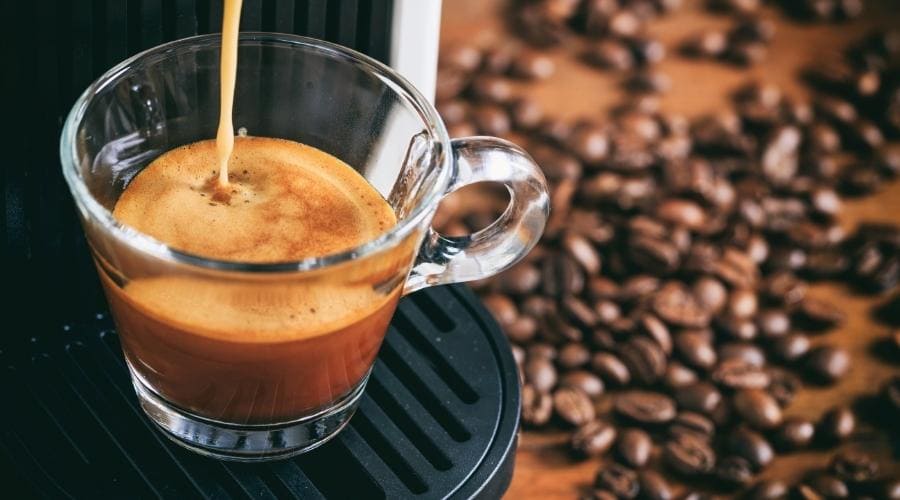
Nespresso coffee usually tastes a tad bit bold with a hint of sweetness and sharp undertones — these three elements swirling, popping melodically in your mouth is the closest thing to a blessed morning cuppa. However, when nespresso tastes burnt, moldy or bitter, that morning joe’s energy pump just falls flat.
Reasons why Nespresso Tastes burnt
After extensive research, I’ve come up with 6 of the most Likely reasons why your Nespresso’s natural flavor is lost or altered, and how to take it from bitter to better!
First off, the amount of coffee should be proportionate to the amount of water. Anything less or anything more would be pivotal in your preparing your perfect cup of coffee. That’s why Nespresso has specifically indicated coffee and water proportions:
1. Nespresso cup size setting
It’s Important to stick to the recommended cup size for each type of coffee drink you wish to brew. Below are the recommendations from Nespresso
- Ristretto (25 ml / 0.84 oz)
- Espresso (40 ml / 1.35 oz)
- Lungo (110 ml / 3.7 oz)
- Americano (25 ml / 0.84 oz coffee; 125 ml / 4.2 oz hot water)
- Hot water (200 ml / 6.7 oz)
Meantime, should you opt to take your coffee experience to the ultimate level, you may want to get your hand on the Vertuo Machine as it caters to “coffee drinkers who also enjoy espresso drinks.”
But if you do happen to have one yourself and your nespresso tastes burnt still, or if you’re ultimately sure that your water to coffee setting is not the root cause, I hear you…
As a matter of fact, I have also had the same issue, the right amount of water, the optimal amount of coffee, yet why does my nespresso taste like burnt cardboard?
Being a coffee enthusiast, I don’t settle for anything less than my perfect cup of joe. This has led me to discover other equally crucial parameters like temperature, timing, water …
2. Nespresso temperature setting
Temperature setting is essential to coffee making. For Nespresso, the best temperature when brewing coffee is between 91 degrees and 96 degrees.
This also holds true based on a study made by the Coffee Tea Club. Awarded as Top 10 UK Coffee Blog, according to the Coffee Tea Club, the ideal water temperature to brew coffee is between 90 to 95 degrees as it achieves optimum extraction.
Source: Coffee Tea Club
Further, Ms. Abigail Harris Shea (Creative Director – New York) stated that the complexity and craft that goes into making an excellent coffee is made possible in under 60 seconds through the Nespresso machine (Source ).
3. Nespresso water hardness setting
Hard water is high in dissolved minerals like calcium and magnesium, and that can be a nuisance especially to coffee makers. As Per the Water Research Center, there are various sources affecting the hardness of drinking water. (Source)
| Classification | Hardness in mg-CaCO3/L |
|---|---|
| Soft | 0–60 |
| Moderately hard | 61–120 |
| Hard | 121–180 |
| Very hard | ≥ 181 |
And sure enough, Nespresso is aware of the effect that has on the final product, this is why, on the first page of every Nespresso machine manual, you will find a test sticker to test the water hardness and prepare your machine as well as your coffee for it.
Now, if you’ve met all of the above criteria in making great coffee yet your coffee is just not on point? Well, it’s time to explore another equally important reason why your nespresso tastes burnt.
4. Your Nespresso Needs A Proper cleaning Cycle:
With each use, It’s pretty common to have coffee grounds, oils as well as any other materials or residue build-up within your machine, this is why it’s always advised to remove used nespresso capsules right after each use and not let it linger in the extraction system.
Leaving the capsule in will cause more grounds to travel into the machine, resulting in a nespresso coffee that tastes burnt and bitter.
If you haven’t been doing this, your best bet is to let the water flow for several cycles in order to clean the remains of coffee grounds.
Dry water cycles are also a good practice to be adopted every now and then in order to keep your machine cleaner and way more efficient.
Emptying the capsule container and drip tray is also highly recommended to avoid overflowing.
5. Nespresso descaling setting
As you may already know, overtime, Nespresso machines —Or any other coffee machines for that matter will require regular maintenance to preserve the quality of cuppa.
That’s because, with regular use, deposits from water (otherwise referred to as scales) will cling to your machine, resulting in a burnt and metallic tasting coffee.
How often to descale Nespresso?
It is highly advisable that you descale your Nespresso machine once every 6 months, or every 600 cups, whichever comes first.
This is also important to take into account if your machine is regularly used by multiple family members, friends, or colleagues. You’ll know then that it’s highly likely that your Nespresso will need to be descaled way more often than every 6 months.
Also, definitely refrain from doing the same deadly mistake many people do. You will find a lot of DIY descaling solutions over the internet, recommending different things.
But Never use vinegar or baking soda to descale or clean your espresso.
If anything, this is just burnt and bitter coffee concoction waiting to happen inside your Nespresso.

Doing this will also leave the all too familiar vinegar smell ‘lurking’ within the crevices of your Nespresso, and believe me, that will take ages to get rid of.
Simple as it is, Nespresso actually have their own recommended descaling kit (Found on Amazon). Given that most people only descale their machine once every six months, This is definitely a good buy.
Meantime, below is a quick guide on how to descale your Nespresso machine (VertuoLine)
What if Nespresso tastes bad after descaling?
If your Nespresso tastes bad after descaling, chances are, the machine was not properly descaled or cleaned. If this happened to you, chances are, your nespresso machine has a specific descaling requirement that’s different than the standard procedure.
The best thing to do in this case is to re-descale your nespresso following a machine specific process (you may refer to this link Machine Assistance | Coffee Machines| Nespresso
6. Using bad or Bitter Nespresso pods
Sometimes, when you’ve tried everything. it’s time to switch your attention from the machine and direct it into them pods!
You might be the victim of a bad batch, or your capsules might have already expired.
A third reason might be that your Nespresso pods are simply too bitter for your liking.
I’ve hand-picked the 3 Nespresso pod flavors below as these are known to be the least bitter pods:
- Dark cocoa and malted cereal.
- Vanilla on a base of malted cereal.
- Vanilla, caramel and coconut notes blending in with the malted cereal character.
As a general rule of thumb, I tend to lean towards vanilla, caramel, and cocoa.
The cocoa masks the bitter notes of espresso while vanilla and caramel perfectly compliment its after taste.
I personally enjoy any of these with cookie butter biscuits or a slice of my favorite cheesecake for an afternoon snack.
Best way to sweeten Nespresso
You can never go wrong with brown sugar. It works wonders for me, almost always as it subtly masks the bitter undertones of coffee yet compliments it to a tee.
It doesn’t hurt to try Muscovado sugar (Link to Amazon) too if it’s available in your area.

Another must try is the humble condensed milk. As simple as it, this milk is decadent when added to coffee, the reason why Vietnamese coffee is gaining a name for itself nowadays.
You may also want to invest in a good coffee cup. It does not need to be expensive. My personal faves are crystal coffee glasses and good ceramic mugs.
Having your favorite drink on your favorite mugs or cup or glass whichever you prefer, just takes the coffee experience to a whole new level.
Conclusion
I hope that you enjoyed reading this article as much as I enjoyed writing it.
My goal is that after reading this you look at Nespresso in a different light and you’ll have a deeper appreciation for the whole coffee experience
While I’ve never had the same experience with Nespresso per se, having been a coffee aficionado since grade school, I’ve had my fair share of bitter tasting coffee too.
Mind you, it was not the pleasant kind.
I think the best way to describe it is when you watch an action movie and the scene was several policemen in graveyard shifts, gobbling donuts, gulping down a hot drink, often referred to as brewed sweat socks guised as coffee Uh-huh.
That bad! That experience was so awful that it moved me to put on my Nancy Drew thinking cap.
As young as I was, the first mystery that I have unraveled was the cup size setting. Genius?
Not really. It’s pretty straight forward.
The amount of coffee that I should put in water should be proportionate to each other. Too much coffee, not enough water, ergo, bitter coffee.
P.S.
Not by chance that the these countries with the most coffee consumption are also the happiest people on earth 🙂
